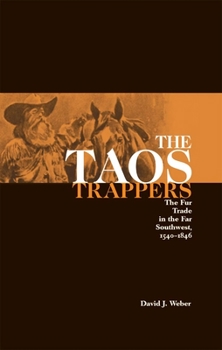The Taos Trappers: The Fur Trade in the Far Southwest, 1540-1846
Select Format
Select Condition 
Book Overview
In this comprehensive history, David J. Weber draws on Spanish, Mexican, and American sources to describe the development of the Taos trade and the early penetration of the area by French and American trappers. Within this borderlands region, colorful characters such as Ewing Young, Kit Carson, Peg-leg Smith, and the Robidoux brothers pioneered new trails to the Colorado Basin, the Gila River, and the Pacific and contributed to the wealth that...
Format:Paperback
Language:English
ISBN:0806117028
ISBN13:9780806117027
Release Date:December 1980
Publisher:University of Oklahoma Press
Length:228 Pages
Weight:0.82 lbs.
Dimensions:0.8" x 5.4" x 8.3"
Customer Reviews
4 ratings
Very Specific and Very Good
Published by Thriftbooks.com User , 15 years ago
Only 45 miles north of Santa Fe, New Mexico lays Taos, long a city of early Native American settlement. Today Taos is a primary destination for skiers from around the world but during the early 1800s it was an illicit trading entrepot and a smugglers paradise. While under Spanish control very little was done to tap the fur wealth of the extended surrounding area. Some furs were traded but the annual trading caravans from Chihuahua north to Santa Fe and back record little regarding the movement of fur. The French sought to connect with the Santa Fe - Taos area from New Orleans but were stymied by the Comanche. In 1763 France lost New Orleans to Spain at the close of the French and Indian War and for the next 40 years the Santa Fe-Taos area traded primarily with the Comanche (thus the term Comancheros) and sporadically with San Antonio. But with the Louisiana Purchase in 1803, Americans, primarily those of French descent out of St. Louis, started to filter into the area, settling primarily in Taos. By the time of Mexican Independence in 1824 there was a permanent French-American community from St. Louis, over 100 trappers, in Taos itself. Taos was an open city and held a strategically important location with respect to St. Louis and the nearby Santa Fe Trail. Located in a secluded mountain valley, Taos was an illegal depositary for imports, avoiding the Mexican import duties levied in Santa Fe. The fur trading community at Taos required traps, weapons and other goods from St. Louis and stimulated much of the early trade that developed along the Santa Fe Trail. Moreover, as fur exports from Mexico were not taxed, many of the primary St. Louis trading houses who financed the Taos trappers received payment in fur. With margins often exceeding 500% the economic justification for the exploding fur trade was huge. Originating primarily from Taos, trapping brigades often totaling 80-100 men moved freely into the Salt River area west of today's Phoenix, Arizona, northern Utah, past today's Salt Lake City, and along the front range of the Rocky Mountains, past Denver into today's Wyoming. By 1826 Taos men had pushed west to California where beaver was sold to American sea captains for transshipment east. William Wolfskill's treck to California is best known for inaugurating the route that become known as the Old Spanish Trail, a trace both Wolfskill and the Spanish learned about from the Indians. The profits earned in California were reinvested in mules and horses and driven back to Taos for sale. In 1831 trapper David Jackson of Jackson Hole Wyoming fame, drove his 700 California mules and horses all the way to Kentucky. Thus a remarkable transcontinental trading business headquartered in Taos flourished along the northern Mexican frontier long before the 1846 US War with Mexico. Taos trappers reached their zenith in the early 1830s when silk replaced beaver fur in men's Eastern fashions. While many of these individuals really never amounted to much a
Taos Trappers
Published by Thriftbooks.com User , 15 years ago
Vancouver, Taos and St. Louis were the economic centers of the fur trade in western North America. This is the classic study of the fur trade in the southwest and covers New Mexico, Arizona, eastern Utah, and southern Colorado. A must read if you are interested in the fur trade.
Great Book on Taos Area Fur Trade History
Published by Thriftbooks.com User , 16 years ago
This book is the definitive book on the Taos are fur trade.....Sante Fe trail....Bent's Fort...Etc....It is VERY well researched and documented...The notes are awesome!! I have a couple other David Weber books and I really like his writing style...If you want to read ONE book on the Taos fur trade this is it...If you want to know about the fur trade as a WHOLE then there are better books out there....
The Taos Trappers: The Fur Trade in the Far Southwest, 1540-1846
Published by Thriftbooks.com User , 19 years ago
ONE OF THE MOST RESEARCHED BOOKS I, HAVE READ DEALING WITH THE FUR TRADE AROUND TAOS AND THE SOUTHWEST IN GENERAL. ANYONE INTERESTED IN THIS TIME IN HISTORY WOULD FIND IT VERY INFORMATIVE AND GREAT READING.






